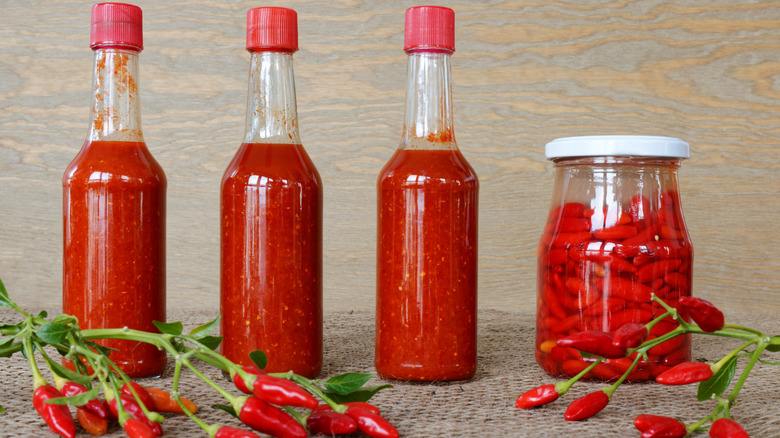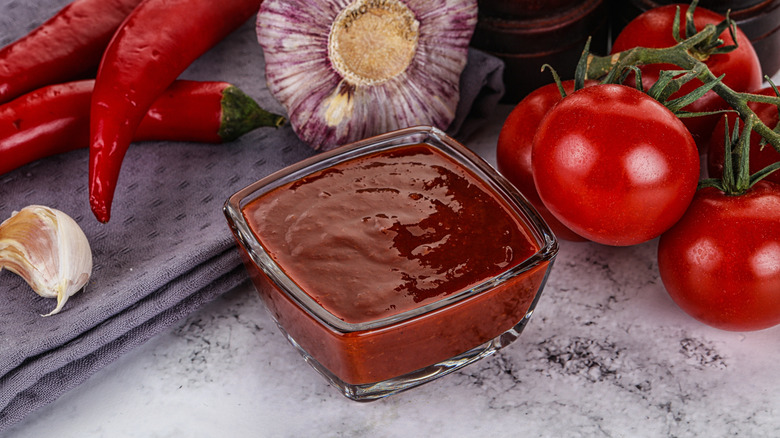Fermentation Is The Flavor Powerhouse Technique Hot Sauce Needs
We may receive a commission on purchases made from links.
Fermentation: the fascinating science behind beloved culinary creations like sauerkraut and kimchi also works wonders with chili peppers for the ultimate flavor-packed hot sauce. Contrary to vinegar-based hot sauces like Cholula, which are made by blending the peppers with salt and vinegar, fermented hot sauces rely on bacterial fermentation instigated by lactic acid bacteria. Lactic acid bacteria are commonly found on the surfaces of fruits and vegetables, including chili peppers, and thrive in low-oxygen and high-salt conditions. This is the exact habitat created by the brine and sealed vessel during fermentation that enables the bacteria to reproduce and grow. During this process, they release lactic acid, which imparts zesty notes akin to but more complex than the rather one-dimensional profile of vinegar-based hot sauces. Of course, there are the added benefits of gut-friendly probiotics upon fermenting.
Fermented hot sauces also differ from aged hot sauces. Aging hot sauce is important because it develops deep flavors over time and allows them to mingle and infuse into the mix. This differs from the chemistry of lactic acid. There is a world of hot peppers with varying degrees of heat (as this ultimate guide to hot peppers explains), and each variety can offer unique flavor experiences when fermented separately or in different combinations. Similar to how adding herbs to the fermentation vessel is a simple trick for homemade kimchi with a twist, complementary ingredients like garlic, onions, and extra spices can be fermented along with your chosen chilis, paving the way for endless mouthwatering homemade hot sauce creations. There's a reason why sauces and condiments like sriracha and gochujang are cherished in the culinary space — it all comes down to the seemingly simple science that is fermentation.
How to ferment safely and successfully at home
The art of fermentation may sound daunting to novices, and the risk of contamination by microbes that may have joined the mix is not one to take lightly. However, with a few basic steps and handy gadgets, home fermentation is remarkably easy and safe. When it comes to identifying contamination, trust your senses. Properly fermented food should smell pleasantly sour — never putrid or rotten. Colorful molds are a tell-tale sign to discard the batch.
First things first, keep it clean. While you don't need pure sterility (we're deliberately cultivating a type of bacteria), clean hands, utensils, and containers prevent unwanted contaminants. For the actual fermentation mix, salt plays a pivotal role in staving off harmful bacteria from populating the mix. As a general rule of thumb, aim for a 2% to 3% brine solution for fermented hot sauce. Less salt can permit the growth of unwelcome microbes, while too much salt can hinder the lactic acid bacteria. Fermenting hot sauce should be maintained at an optimal temperature range (68 to 72 degrees Fahrenheit) for a rate of fermentation that yields delectable flavors. Typically, a week-long fermentation period suffices for hot sauce, but longer periods to the tune of several months allow more complex flavors to develop. To extend shelf life, stop the fermentation process once the desired result is achieved by lowering the pH with extra vinegar.
An anaerobic (oxygen-free) environment is essential to keeping the lactic acid bacteria happy and healthy. Invest in air locks or dedicated fermentation vessels to keep the mixture sealed from oxygen. You should also keep it away from bright light. Be mindful that fermentation results in carbon dioxide release, so to avoid pressure build-up and your vessel exploding, it's worth having a pressure release valve. You can also "burp" the container by regularly and briefly opening and closing it throughout the fermentation period to allow the gas to escape. With these basic principles, there's no stopping your inner fermentation fiend from spicing up the kitchen with delicious hot sauces.

